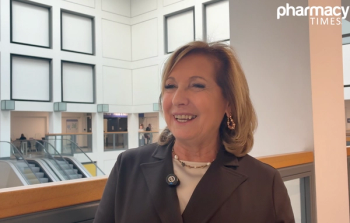
Practice Pearl 2: Managing AEs With PARPi Therapy in Ovarian Cancer
Drs Bradley J. Monk, Sarah Hayward, and Jennifer MacDonald comment on monitoring and managing adverse events with PARP inhibitor therapy in patients with ovarian cancer in the frontline maintenance setting.
Episodes in this series

Jennifer MacDonald, PharmD, BCOP: Sarah, the 1 thing we didn’t touch on with niraparib [Zejula] is blood pressure monitoring.
Bradley J. Monk, MD, FACS, FACOG: Yes.
Sarah Hayward, PharmD, BCOP: Yes, absolutely.
Jennifer MacDonald, PharmD, BCOP: Do you want to touch on that a bit?
Sarah Hayward, PharmD, BCOP: Sure. This is definitely 1 of the more drug-specific adverse effects that’s important to counsel a patient on. It’s not really a class effect, but we’ve had patients who have had hypertension, or tachycardia, from being on niraparib. I believe the manufacturer recommends doing blood pressure checks once a week for the first month and then monthly.
Bradley J. Monk, MD, FACS, FACOG: Yes, that’s right.
Sarah Hayward, PharmD, BCOP: That also might depend on your patient. Do they have preexisting hypertension that’s already needing management? I just direct it like I do with patients who are on bevacizumab [Avastin], which is 1 of the big adverse effects we see. I just ask them to take it once a day because it makes a habit out of it. I can see a better trend over time. Plus, given where I live in Oklahoma, there’s a high incidence of hypertension and other comorbid diseases. So we do that, and we listen to the patient. There have been a couple patients in whom we’ve had to switch therapy because they had significant tachycardia specifically with that. They said, “I’m lying in bed and my heart is racing, and I don’t like this at all.” I said, “I don’t blame you.” That’s definitely something to do. Also, not every patient has access to a home blood pressure monitor cuff, so keep that in mind as well. But if they do, I just go with the once daily approach because we can see better trends.
Bradley J. Monk, MD, FACS, FACOG: Speaking of once daily, that’s the beauty of niraparib. If you take niraparib at night with a small meal and an antiemetic, the fatigue is ameliorated because you get a good night’s rest because the antiemetic is also sedating. Our favorite is olanzapine. The nausea associated with PARP inhibitors is gastric and small intestine irritation, not blood level chemotactic trigger zone related. You can give niraparib, a small meal, maybe 2.5 or 5 mg of olanzapine, get a good night’s rest, and you’ve got everything solved. That improves compliance and is 1 of the unique aspects. Every PARP inhibitor has plusses and minuses. The other 1 that we haven’t talked about is the elevation in the liver enzymes for rucaparib [Rubraca]. They’re all different.
Jennifer MacDonald, PharmD, BCOP: Yes. I’ve seen some patients who struggle bad with insomnia with the niraparib, and then they’ve been taking it at night, so we try to move it to the morning just to see.
Bradley J. Monk, MD, FACS, FACOG: Take it at night with olanzapine. Your patient isn’t going to be awake all night if you give her 5 to 10 mg of olanzapine.
Jennifer MacDonald, PharmD, BCOP: But then it’s funny. I’ve had spouses be like, “Yes, but then she’s up at 3 AM cleaning the whole house, so we didn’t really mind it that much.”
Bradley J. Monk, MD, FACS, FACOG: Yes, that’s really funny.
Jennifer MacDonald, PharmD, BCOP: We’re going to try to work on that. There are a lot of different strategies that you can use to help get patients through these toxicities. That’s where the collaborative piece really comes in with using pharmacy, nursing, physicians—the whole team—to really come together. The patient may feel more comfortable disclosing some of these things or talking about some of these things with the nurse that they’re really close with, or maybe it’s the pharmacist or the physician.
I had a patient yesterday who was totally fine. She was asking me about how my Thanksgiving went and all this stuff, and then she told the physician, “I’ve been kind of depressed.” I’m like, “I didn’t get any of that from the patient when I was in the room.” Patients will sometimes feel more comfortable disclosing things to different people and it takes everyone coming together to put your heads together. Like you said, “Add the olanzapine. See if that will help.” What are some other things that we can do to help this patient get through and maximize that quality of life we talked about?
Bradley J. Monk, MD, FACS, FACOG: The other learning point is fatigue. Fatigue is such a complex symptom, and the most common cause of fatigue for you and me is sleep deprivation. The most common cause of fatigue here in Arizona is dehydration, depression, malnutrition, metabolic disorders including hypothyroidism, anemia, and concomitant medications. But I’d hate for someone to dose reduce a PARP inhibitor or interrupt and dose reduce simply because they’re tired, even though they’re sleeping 4 hours a night. You have to get the diagnosis right to get the treatment right.
Jennifer MacDonald, PharmD, BCOP: Definitely. And sometimes I’ve learned that the patient always slept 4 hours a night their whole life, so this isn’t necessarily new for them.
Bradley J. Monk, MD, FACS, FACOG: Yes, that’s a good point. I can’t even imagine. I need my beauty sleep.
Jennifer MacDonald, PharmD, BCOP: Yes, I hear that. That wraps up this section on the frontline maintenance therapy. Are there any last minute thoughts or anything that we think we missed so far?
Bradley J. Monk, MD, FACS, FACOG: I just wanted to thank you for what you’re doing for the patients. Pharmacists are so important, along with patient navigators and nurses. It’s a team approach. You really can’t give these oral anti-cancer therapies without a team.
Jennifer MacDonald, PharmD, BCOP: Yes, definitely. I appreciate my specialty colleagues, like Sarah mentioned, who do a lot of help with following up with me with the volume and everything. There’s only so much of me to go around sometimes, so I appreciate the team effort. Whether it’s even CVS Specialty or some other specialty pharmacy that’s doing it, it’s really helpful.
Transcript Edited for Clarity
Newsletter
Stay informed on drug updates, treatment guidelines, and pharmacy practice trends—subscribe to Pharmacy Times for weekly clinical insights.














































































































































































































